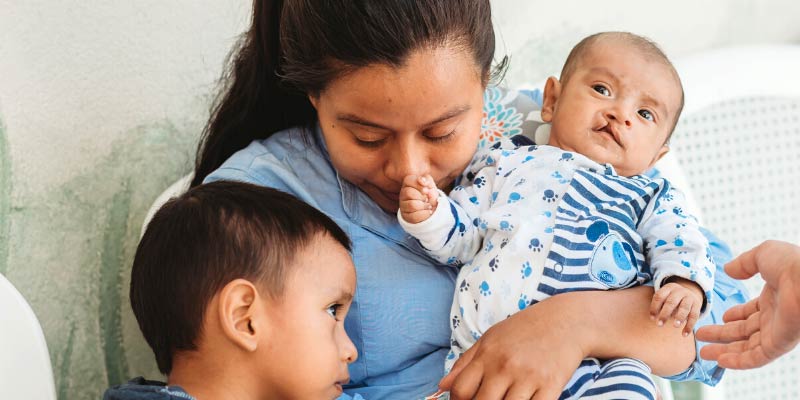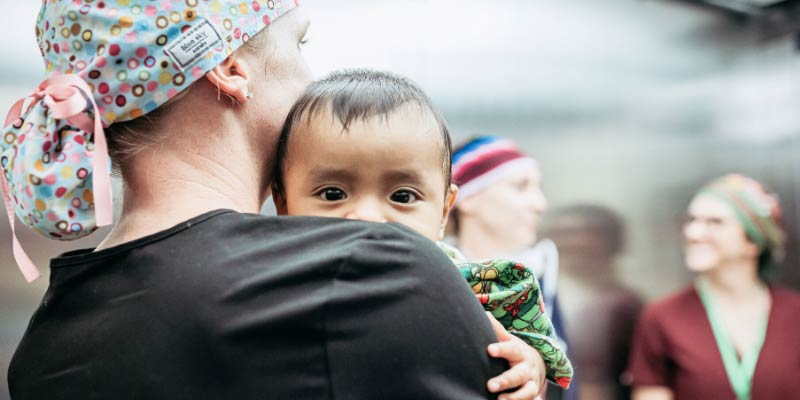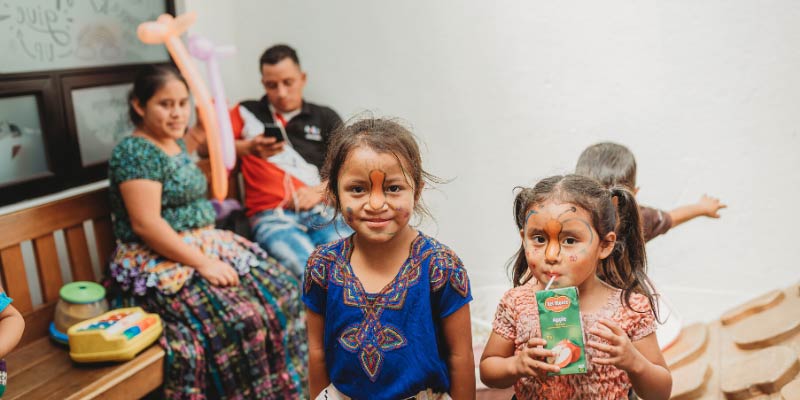by John Paschal
In the evening dimness of room 6, nurse Pearl Falkenberg leaned across the silver rail of the small crib and, with a handheld fan, cooled the baby and his mom, who stood beside the nurse at the edge of the baby bed. Just below the two women, one-year-old Rodrigo Ramos Lopez lay crying and sweaty, his tiny legs kicking at warm air while his mother tried to soothe him with soft words and caresses. Moments hence, as silence took hold of the baby, the women began conversing in Spanish, their words in soft and measured tones.
Pearl glanced at me. “A few minutes ago he was really screaming and sweaty,” she explained as I stood by the crib at 5:20 p.m. on Thursday, Nov. 7, the final day of surgery during the Austin Smiles medical mission in Guatemala City. “The father was holding him and he was just a mess. So I went out and got the mother, and we gave Dad a break.”
The nurse turned back to Rodrigo, who two hours earlier had undergone a cleft lip repair and an ear-tube placement here at the Moore Pediatric Surgery Center, situated in a cramped neighborhood in the thick of the city. She smiled at the boy. Calmer now, and quiet, he began sipping Gatorade from the plastic syringe in his mother’s right hand.
“Now,” said the nurse, “everybody’s doing a little better.”
At the moment, Rodrigo was one of nearly 60 patients who had undergone reconstructive craniofacial and/or ENT surgery at the MPSC as part of the Austin Plastic Surgery Foundation’s 76th international medical mission. About a half dozen more — in fact, the last half dozen of the mission — were currently upstairs, either in one of the ORs or in the recovery room, where nurses were easing their transitions to overnight rooms like Rodrigo’s. It seemed safe to say by now that were it not for the medical mission, these were rooms that the children, all from poverty, might never have entered.
“You should hear what some of the parents say to me,” Pearl told me as we sat in adjacent chairs just outside room 6. “Three separate parents have said, ‘You all don’t know what this means to us, because we would not have had a way to pay for this kind of procedure. We would never be able to get this kind of help.'”
The helping, the helpers, the helped
At 7:20 a.m. on Thursday, several hours before Rodrigo Ramos Lopez is scheduled to undergo surgery with Dr. Bill Gorman in OR1, the 32 members of the Austin Smiles team disembark from their two vans and enter the MPSC courtyard, a small but pleasant space that features a mural of Noah’s Ark and a colorful sky-spanning rainbow. Behind us, in a sense, are the historical totals of nearly $15 million in donated medical services, more than $1.25 million in donated medical supplies, nearly 175,000 mission-volunteer hours and 14,000 local-community volunteer hours, all coordinated or in some way helped along by Austin Smiles Executive Director Kendyl Richards and her staff, Mission Administrator Martha Mashburn and Medical Missions Director Leilani Briseno.
In front of us, peering out the window of overnight room 5, is four-year-old Mario Concoba. Having undergone an ear-tube placement on Wednesday, Mario, a stout boy with thick black hair, is pressing his palms against the glass as he smiles at the Austin Smiles team, his brown eyes better windows than the glass he peers through. Reciprocal, Martha Mashburn returns the boy’s smile and then presses her palms against the glass directly across from his, causing Mario to launch into laughter that we can’t hear but can certainly see. Moments later, Dr. Syboney Zapata, who performed the boy’s surgery, enters Mario’s room, says hello to his mother, reaches down and gives Mario a hug.
“Buenos dias!” she says, lifting and then cradling the boy dressed in green pants and colorful Mario Brothers T-shirt.
With a grin, the surgeon then turns to Mario’s mother, Tomasa, who, like the other guardians here, spent the night in a chair directly at bedside. Looking up, Tomasa smiles at Dr. Zapata and says, in Spanish, “Thank you so much. He is doing so well now. He has always been a happy little boy, but now I can see he feels so much better.”
Just as Dr. Zapata eases Mario back to his bed, Tomasa pulls from a bag a small, vibrantly colorful table cover. She smiles and hands it to the doctor. “This is for you. Thank you.”
“Oh!” exclaims the doctor, taking the gift in her hands. “Thank you!”
Precisely 10 hours later, after spending the day posting pictures that told better stories than words ever could, I am sitting with Pearl Falkenberg, post-op nurse, in the hallway between rooms 5 and 6 — on one side Mario’s morning room and on the other side Rodrigo’s current room. For five days now, the same hallway has served as a spatial and temporal suture, tying together children and doctors, doctors and nurses, nurses and volunteers and parents, parents and staffers and children, and children and other children, each preceding or replacing another in this most sympathetic of surgery mills.
So much has happened here, the echoes still in the hall: On Sunday, in the ENT screening room just down the way, I watched as 14-month-old Cristaal Lopez cried in her mother’s arms, aware only of the discomfort and fear and not of some alternate future that waited for her to have it — a future when, with her cleft palate closed, she speaks as well as any kid at school, and when food doesn’t press into her sinuses and even her ears after she eats.
I watched, too, as 10-month-old Elva Ballera cried in her mother’s arms, too young to understand that this stranger is here to help, to correct a problem that she cannot yet comprehend but that if left unchecked will greatly damage her life. And there were the other kids, too, so many through the door, one after the other, each with a guardian who cared enough, loved enough, to make the journey. There was Juliana Letran, 7, who laughed at a leonine stethoscope. So easy it was to see her beautiful eyes and bright smile and forget the abnormality. You see the laughter and the joy in a child like Juliana and you think, Hey, this child is happy, happy enough. But then you understand how much better the near and distant futures might be; happier years are a surgery away, hours given over to earned expertise. There is more to it, of course. Life isn’t so simple, isn’t just a one-to-one ratio of surgery to lifetime happiness. But really it just has to help. It’s impossible to think otherwise. If it’s possible to think otherwise, none of us would be here.
The kids of Grupo 1 kept coming that day: Christopher Ortega Retana, 4, with his dashing anchorman haircut; Diego Yalibat, 5, in the coolest little track suit ever; Felix Casimiro, 8, with his constant smile; 12-year-old Henry Herrera, so stoic, so incredibly grown-up and tough. But who knew how he’d act once he underwent a cleft palate repair that kids in America typically undergo before their first birthday? Of course there was also Angel Yal, 12, escorted by his older brother because their mother had just died.
Additional bad news — that the mission isn’t equipped to fix his perforated eardrum — met with the same stoicism I had heard about. The brothers said thank you and left the room.
Behind us now, Rodrigo has stopped crying and is still sipping Gatorade. For once, silence comes a river through the hallway, turning up memories even as Pearl begins to talk.
Henry Bamaca, palate. Maria Garcia, nose. Flor Lopez Herrera, frightened but also brave. And Sharis Coyoy, a 10-year-old girl from Jutiapa who had already undergone three previous surgeries and now stood ready for three more — a rhinoplasty, an otoplasty and a lip revision, all scheduled for one surgical block. On Sunday she held her mother’s hand.
And then there was Alejandra Ochoa, nine months young, who, while sitting on the lap of her mother, Aura, began grinning through her cleft lip even as MPSC Medical Director Dr. Ligia Figueroa entered the room to collect information slips for help in devising the surgical schedule. On Alejandra’s little pink onesie were the words, “All eyes on me!”
Indeed. Por supuesto.
The helped, the helping, the helpers
“These parents,” Pearl is saying, “they feel the same pain the baby is feeling.”
Behind us, Rodrigo is drifting to sleep as his mom slides her fingers through his wispy black hair. Down the hall, three other kids are resting in room 9, where, on the morning before her own surgeries, Sharis Coyoy watched Toy Story on the TV in the corner while telling us that she wants to be like Jessie, a cowgirl, and where, after her surgeries, she sat with her head and face bandaged while her mom, Carina, held her hand.
“I’m telling you,” Pearl goes on, “they really do feel it.”
One mom, Pearl recalls, needed to dab blood from her child’s nose and lips. “But she couldn’t do it,” the nurse explains. “She knew, or thought, it would hurt. So she asked me, ‘Please pat it for me.'”
Pearl is smiling at the memory, and shaking her head just a bit. “Later, just before she left, she told me, ‘You’re gonna remember me forever, because I was such a big baby.’ I told her, ‘No, I’m gonna remember you forever because you’re such a good mom.'”
The hallway is quiet still. In it are conjured phantoms of earlier times, when mothers sat in nearby chairs while cradling, even nursing, their kids. Through earlier days and weeks and even years — the U.S.-based Shalom Foundation built the surgery center in 2011 in order to host numerous such medical missions each year — the same hallway has joined similar moments to singular people, those parents and patients who have never done this before: the wheelchair to the waiting area, the waiting area to the elevator, the elevator to the ORs.
Just down the hall from these chairs, in a separate but connected time, the parents are waiting to see the elevator open again, and to see their kids in a way they haven’t known.
Here now, Pearl calls up a memory. One of 30 Austin Smiles volunteers on the mission, she says that one mother asked, “Does your government pay for your trip?”
“I said no,” the nurse recalls. “She asked me who pays for it. I said, ‘Do you really want to know?’ She said yes. I said we pay our own way. I said everyone here pays for their own trip.”
Stunned, the woman asked, “How can you do that?”
Pearl told her, “We do it because we want to.”
From down the hall comes a baby’s cry. We walk to room 2 to find one-year-old Dante Morales, just out of a bilateral lip repair and tube placement, in a grumpy mood.
“OK, Mamita,” Pearl tells his grandmother. “Take a break. I’ve got this.”
Moments later, scrub tech Jill DeCabooter, who on Sunday cradled Dante in the ENT screening room, enters the room 2 and tells Pearl that she herself can take a break. Still dressed in scrubs from a just-concluded surgery, Jill takes the boy in her arms and sits on a chair. She settles him in her lap. Saliva is bubbling between his lips as he whimpers and cries. She runs her fingernails through his wispy hair, wipes the tears from his face.
Watching, I reason that she and her OR3 team must have performed Dante’s surgery.
“Oh, no,” says Jill, shaking her head just as Dante stops crying. “I don’t know if I could have done that. I don’t know if I could have taken it. Sometimes the bond just gets crazy.”
The helping all around
At 5:55, just minutes after giving Dante a goodnight hug, I walk to the rooftop patio and climb the stairs to a third-floor perch. Lights on distant mountaintops are speckling the space between land and sky, a rippled horizon splitting equal parts of darkness. In the other direction, gauzy gray clouds are sliding across a silver western sky, the sun in descent having hoisted this unusual color. On nearby rooftops the clothes are drying on drooped gray lines, lazy flags in a thin wind. A rumble is rising from a tight web of streets, settling across the echoes of disembodied Spanish, the conversation unseen.
The rumble ends. The talk fades away. In silence, memories arrive at the mind: the speech pathologist, Katherine, creating space wherever she can to help kids pronounce T’s and roll R’s; Dona Alba, a Guatemalan mom, walking with her daughter to MPSC because the roads near her El Quiche village were too muddy for a bus; Beau, the volunteer good guy, drifting amiably from room to room, speaking gently with kids and patting their moms and dads on the shoulder; mission drivers Raul and Carlos and Israel, always cheerful, always punctual, and Israel selling souvenir machetes out of his van; Kris, the volunteer photographer, corralling with a lens what is otherwise so hard to convey.
Back inside, the final surgeries are nearing their ends. The mood is cheerful but not yet valedictory; there is still work to be done, sutures to close, children to wake. In recovery, nine-year-old Victor Palma sits up. Just into consciousness, he asks for something to drink. Leaning in, nurse Debbie Wilder gives him some Gatorade. He gulps.
Ten feet away, nurse Mary Kay Lauden is lifting Reyna Samayoa Barrios from her bed.
“Can you bring a toy over here?” she says to anyone who might respond.
“Boy or a girl?” comes the reply.
“Girl.”
Across the room, scrub tech Vanessa Little rummages through a donation of stuffed toys and comes up with a rhinoceros.
“A rhino for the ‘rhino,'” quips Dr. Fred Wilder, who performed Reyna’s rhinoplasty.
Hugging her animal, Reyna is placed in a wheelchair and steered into the elevator. In moments its doors will open to begin a new stretch of time.
Back in OR2, the team is cleaning up and packing instruments. While working, CRNA Dan Ernst, who participated in an Austin Smiles mission at MPSC just two weeks earlier, tells me, “This has been a good week. Of course, I wish we could do more. There is always more you could do. But at some point you just have to accept the inevitable, that somebody will be here behind you to carry on this type of mission.”
Continuing the clean-up, nurse Sherry Millington looks up with a chuckle.
“Hey,” she says to Dan, “we have to keep it looking fun or no one else will do it!”
Back in recovery, Dr. Bill Gorman walks in with a coffee in one hand and a sangria in the other. “Happy hour!” he declares with a grin. “Sort of.”
Nearby, the final patients from ORs 1 and 3 are beginning to wake.
Fresh off a frenulectomy, Javier Moton is placed in a wheelchair for the trip to the first floor. His anesthesiologist, Dr. Quint Barnes, leans down to give the five-year-old a fist bump. Dr. Zapata, who performed his frenulectomy, asks him to stick out his tongue.
He giggles, then sticks it out.
“He’s never been able to do that before,” says the surgeon, satisfied.
Meantime, Guatemalan volunteer Katina Safia is patting the shoulders of Dania Taquez Orozco, a three-year-old ear-tube patient asleep in a blue gown.
“Dania, habre los ojos,” Katina says softly. “Habre los ojos.”
Eyes opened, Dania is soon in the arms of Debbie Wilder, her head on the nurse’s shoulder. Having retrieved a stuffed animal, Katina hands it to Dania. Shaking her head, the child says no. Katina hands her another stuffed animal, then another.
Still shaking her head, Dania rejects them both and declares, “I want Mickey Mouse.”
Nearby, Mary Kay Lauden laughs. “Dania,” she says, still laughing, “you should have put in your request ahead of time!”
Sticking to her principles, Dania sits in a wheelchair without a stuffed toy, smiling as she is rolled away. Behind her, the mission’s final patient is placed in her own wheelchair and steered toward the doors. On the elevator, Maite Murrillo Guzman is asked to stick out her tongue. On command, the six-year-old frenuloplasty patient does so. When told she is the week’s final patient, she issues a shy smile. In moments the elevator doors slide open, and Maite’s mother, Maritza, rushes to greet her. Leaning into each other, they hug.
Turning back, we step onto the elevator. Moments later I pocket my notebook, upset that I’ve not gotten that Great Closing Quote — you know the one, something like “We do it for the children, et cetera, et cetera” — the grand summation of a sentiment that by now should be so clear. And really, it is. It’s clear. The proof is in the actions, not in the words.



